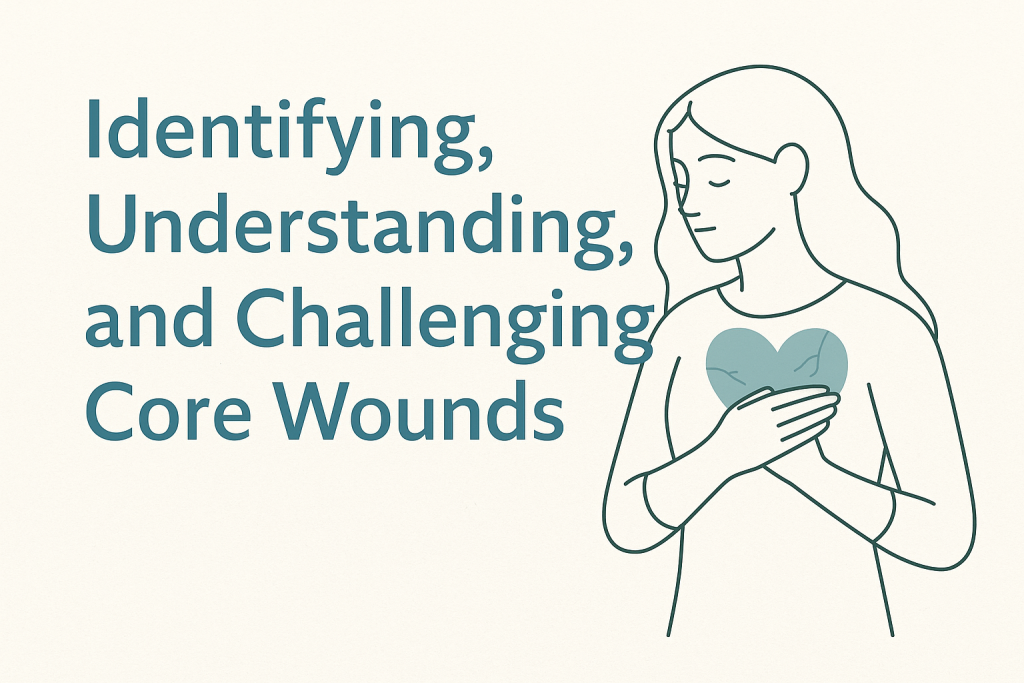Each of us carries emotional wounds—some small, others so deep they quietly shape the course of our lives. These are what we call core wounds: the internalized beliefs about ourselves that often stem from early experiences, especially those involving shame, neglect, or abandonment. They’re not always obvious, but they show up in how we view our worth, how we handle relationships, and how we respond to stress and fear.
What Are Core Wounds?
Core wounds aren’t just “bad memories.” They’re the stories we began to tell ourselves as children—stories like “I’m not enough,” “I’m unlovable,” “If I show who I really am, I’ll be rejected.” These beliefs are survival-based and usually formed in response to trauma or unmet needs in childhood. Over time, they become deeply embedded, shaping our identity and self-concept.
“All psychological wounds are one wound, basically, and that is the wound around love and being disconnected from love.”
— John Welwood 🔗Source

Step One: Identifying the Wound
The first step toward healing is awareness. What are the recurring emotional patterns in your life? Do you find yourself avoiding intimacy, fearing abandonment, or struggling with perfectionism? Often, these behaviors are protective responses to a core wound. Start noticing when strong emotions feel disproportionate to the situation—they’re likely pointing you toward a deeper hurt.
Ask yourself:
- What situations consistently trigger deep shame, fear, or anger?
- What negative beliefs do I hold about myself during these moments?
- When did I first feel this way?
Identifying your wound is not about blame—it’s about understanding the roots of your pain so you can finally release it.
Step Two: Understanding and Reframing
Once the wound is identified, we begin the work of understanding its origins. This is where psychoeducation becomes powerful. Learning about attachment theory, the stress response, and the role of the nervous system gives context to your reactions and removes shame from the equation. You begin to see that your responses weren’t flaws—they were adaptations.
Reframing is about shifting perspective. For example, instead of seeing your hyper-independence as a failure to trust others, you can view it as a brilliant survival strategy you developed early on. This doesn’t mean you stay stuck in the past—it means you honor the role it played and gently begin building new ways of being.
Step Three: Challenging the Narrative
Challenging core wounds is delicate work. These beliefs have often been reinforced for years. But with curiosity, compassion, and practice, you can begin to rewrite the script.
Some helpful tools:
- Affirmations grounded in reality: Not “I’m perfect,” but “I’m worthy, even when I’m struggling.”
- Inner child work: Visualize the younger version of yourself and offer them the love and words they never received.
- Somatic practices: The body stores trauma. Yoga, breathwork, and nervous system regulation can help integrate healing on a physical level.
- Therapeutic dialogue: Working with a therapist can help safely challenge old beliefs and replace them with more adaptive, nurturing ones.
You Are Not Broken
Your wounds are not a sign that you’re broken—they’re a sign that you’ve lived, adapted, and survived. And now, you get to choose a new way forward. Healing isn’t about erasing the past. It’s about integrating it, transforming it, and reclaiming the parts of yourself that were left behind.
As you walk this path, remember: Nothing that has come against you has to be in vain. There is hope. There is healing. And it begins within.